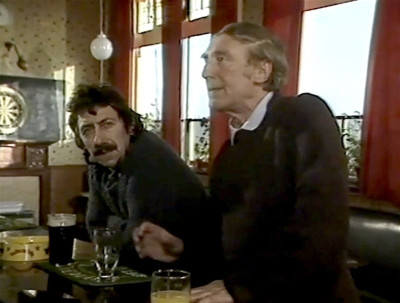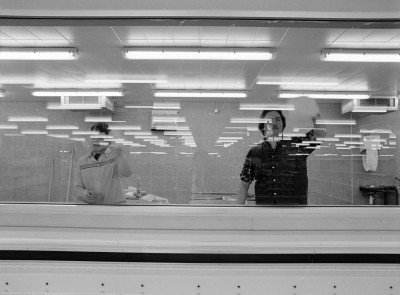
Look Me In The Eye
Richard Grassick
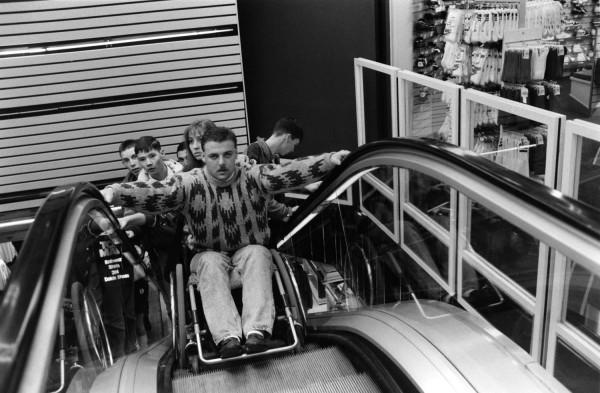
Look Me In The Eye
Richard Grassick
- Photographic
- Primary Source Programme
- Popular Cultures
- Portraits
- UK Documentary
- 1980 – 1989
- Tyne & Wear
- UK
Look Me In the Eye is a photographic exploration of the life of a man with paraplegia, developed in 1988 during Amber’s North Shields residency and exhibited as part of Side Gallery’s issue-based NOW series, which responded to contemporary social issues through contemporary documentary.
The project was made in collaboration with Steve Burns, who became disabled following a workplace accident. Grassick’s photographs follow him at work and at play, challenging assumptions about ability, masculinity and independence. Burns is candid about the way his disability shapes others’ perceptions of him. “I’ve played pool,” he told Grassick, “and I’ve beaten people and they’ve gone away and I’ve heard them say: ‘Bloody hell! Getting beaten by a gimp!’ Because you’ve got a disability, you shouldn’t be beating an able-bodied person. It’s their pride, like they can’t stand being beaten by a woman either.”
Reflecting Amber’s broader commitment to collaborative, community-rooted storytelling, Look Me In The Eye foregrounds lived experience, allowing space for self-representation while confronting viewers with uncomfortable realities. It remains a powerful reflection on visibility, autonomy and the social perceptions that often surround physical disability.
Richard Grassick is a British photographer and filmmaker whose work often focuses on communities in transition, both locally and internationally. He was an active collaborator with Amber Films and Side Gallery through the 1980s and 90s, producing a range of socially engaged projects that explored identity, belonging and representation.
With a background in both still and moving image, Grassick has worked extensively across Europe, particularly in Germany, developing projects that connect personal stories with broader political contexts. His practice is rooted in documentary traditions, but often extends into experimental and participatory modes of production.
Grassick’s commitment to collaborative practice and underrepresented voices has defined much of his career, and his work remains part of the wider legacy of community-focused photography and film in Britain.
Texts by Kitty Fitzgerald from an interview with Steve Burns,1988
Well it all started from a cut finger, from a step ladders I fell off and cut me finger and 3 days later I had to go to the Jubilee Casualty Department, they cut the infection out of my finger and I was off work for 7 days. When back to work in June, 7 weeks later on August 10th. 1984 I felt bad. So I went to me GP and I collapsed in the GP’s surgery, whipped me into casualty. They didn’t know what it was, this was the 10th till the 15th August 1984. They didn’t know whether it was pleurisy or heart attack or bornholms and then eventually on the 15th they found that it was something to do with the spinal cord. So they transferred me to a neurologist up in Newcastle and he diagnosed an abscess on me spine, which had crushed me spinal cord, which left me paralysed. After the operation, I was in there for a month or so, and then I was transferred to Hexham Spinal Unit where I spent several months rehabilitating.
I couldn’t have got through it all without my family, especially my mother. She did become very protective at first, but then we all had to learn to adjust to a new way of living.
I was sensible at 22 before his happend to me but I was still a bit of a tearaway still a bit stupid at times but after this it had to make me grow up, you know, I had to think positive about life, where I was going, which way I was turning. I mean at 22 I felt I was more mature than a 22 year old lad because you still get them roguing about, going out Friday, Saturday, on the drink, just wanting to get blasted out of their minds, you know, be sick. They just live from one week to the next you know I’ve done it before but at 22 when this happened to me I grew up a hell of a lot.
Of course I’ve changed, it would be a lie if I said that I hadn’t. Not a lot but yeah, before that I had that image, without being big headed, I could look after meself when I was able-bodied. If somebody started trouble, if you couldn’t talk it out I would fight it out and you could guarantee I’d come off best the majority of times. Yes, before hand I suppose I did have that macho character but not now.
For years I dreamt I was able-bodied. It was like dreams were real life and waking up was a nightmare. But I had to teach myself to accept it and now I do dream of myself in a wheelchair.
See, what I tend to do at first is to lay the line, you know. I don’t need any help, I don’t need patronising, I can do a lot for myself. Right at the very beginning. People hear that and then if people step over that mark you just say I don’t need a hand, I’m okay. So you tend to right from day one let them know what you can and what you can’t do. You obviously can’t go through everything but you let them know that you’re quite capable of doing the majority of things.
Everybody wants to be on their own sometime of the day or week, and I go into the room and because somebody see’s you quiet or upset the first thing they say is” What’s wrong, talk about it “, cos’ there frightened incase you go inward and top yourself because you’ve had this big trauma you know, it’s happened to me so many times and I say ” just leave me alone”. So I used to go into the dining room and people had to pass from the living room to the kitchen, and if I was in the dining room I could only turn me back to the door and sort of look at the wall, and look and think and think, and people come up and say ” what’s wrong Steve”, and I say “for god’s sake, leave me alone, I just want to be on me own for five minutes”.
You always find a disabled person regardless of whether it is sex or sport or making a point in life will want to prove something. They want to prove that they’re as good if not better than the able-bodied people.
[We've just had] the first niece in our family and it’s direct blood and I’m really excited about it. I’m really looking forward to having the kid for weekends, you know, staying in my extension and coming out with me. She’ll be sitting on me chair and we’ll be going out for walks, eh the baby, meself and me girlfriend, she just has to sit on me knee. Yeah, I do want children but I’ve never give it a thought as yet. I mean I couldn’t cope with one just at the minute, me own personally.

Look Me In the Eye, 1988
- Ref: 091-014-LBW-1
- Date: 1988
- Artist: Richard Grassick
- Copyright: © Richard Grassick
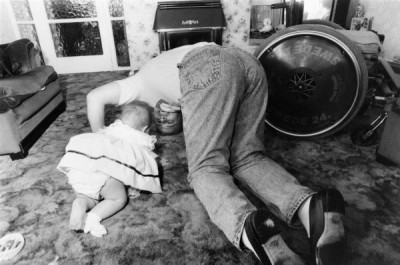
Look Me In the Eye, 1988
- Ref: 091-010-LBW-1
- Date: 1988
- Artist: Richard Grassick
- Copyright: © Richard Grassick
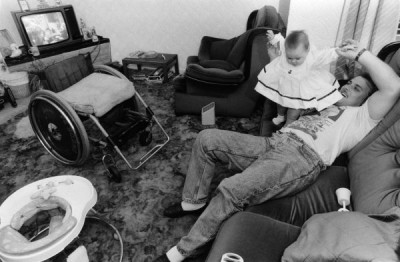
Look Me In the Eye, 1988
- Ref: 091-004-LBW-1
- Date: 1988
- Artist: Richard Grassick
- Copyright: © Richard Grassick
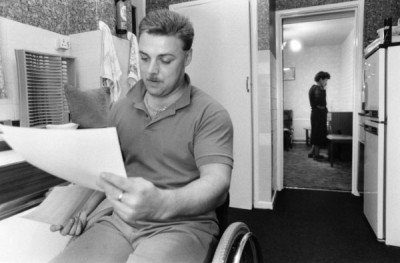
Look Me In the Eye, 1988
- Ref: 091-011-LBW-1
- Date: 1988
- Artist: Richard Grassick
- Copyright: © Richard Grassick

Look Me In the Eye, 1988
- Ref: 091-005-LBW-1
- Date: 1988
- Artist: Richard Grassick
- Copyright: © Richard Grassick
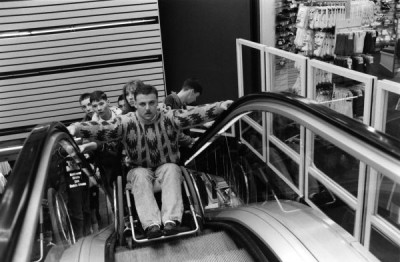
Look Me In the Eye, 1988
- Ref: 091-003-LBW-1
- Date: 1988
- Artist: Richard Grassick
- Copyright: © Richard Grassick
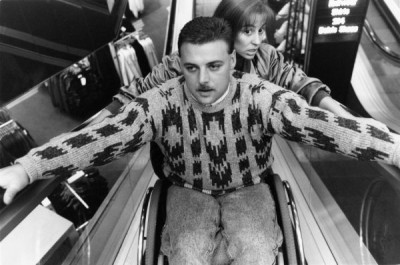
Look Me In the Eye, 1988
- Ref: 091-013-LBW-1
- Date: 1988
- Artist: Richard Grassick
- Copyright: © Richard Grassick
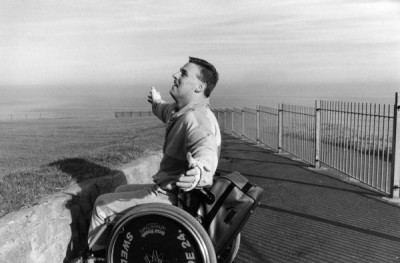
Look Me In the Eye, 1988
- Ref: 091-001-LBW-1
- Date: 1988
- Artist: Richard Grassick
- Copyright: © Richard Grassick
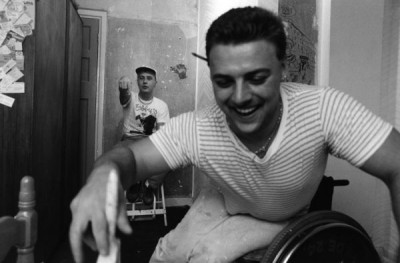
Look Me In the Eye, 1988
- Ref: 091-002-LBW-1
- Date: 1988
- Artist: Richard Grassick
- Copyright: © Richard Grassick
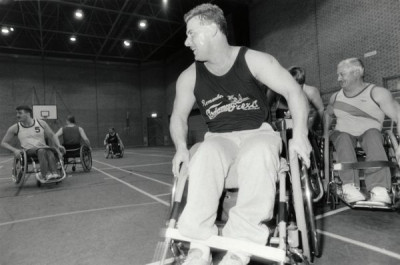
Look Me In the Eye, 1988
- Ref: 091-006-LBW-1
- Date: 1988
- Artist: Richard Grassick
- Copyright: © Richard Grassick
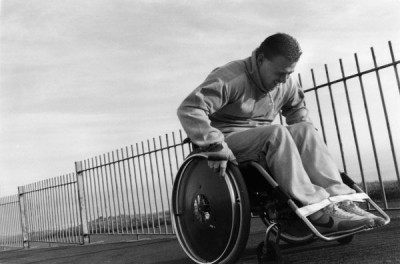
Look Me In the Eye, 1988
- Ref: 091-007-LBW-1
- Date: 1988
- Artist: Richard Grassick
- Copyright: © Richard Grassick
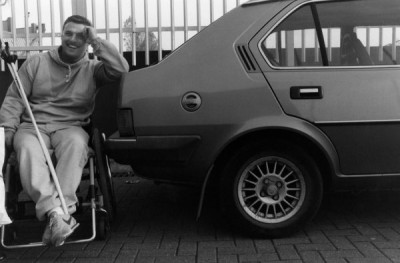
Look Me In the Eye, 1988
- Ref: 091-008-LBW-1
- Date: 1988
- Artist: Richard Grassick
- Copyright: © Richard Grassick
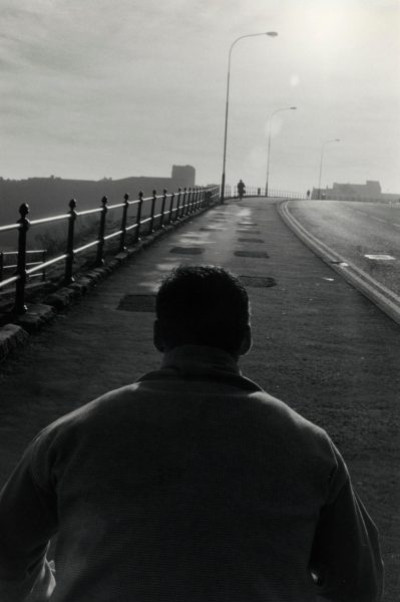
Look Me In the Eye, 1988
- Ref: 091-009-PBW-1
- Date: 1988
- Artist: Richard Grassick
- Copyright: © Richard Grassick
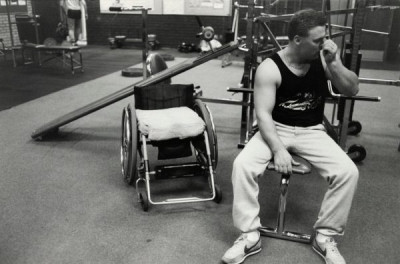
Look Me In the Eye, 1988
- Ref: 091-012-LBW-1
- Date: 1988
- Artist: Richard Grassick
- Copyright: Look Me In the Eye, 1988
Related Works

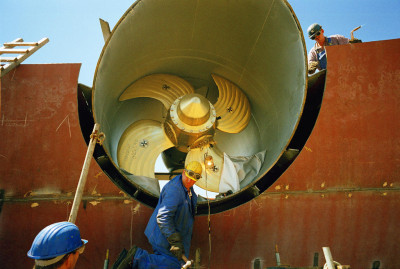
Post Industrial
Richard Grassick
Photographic
